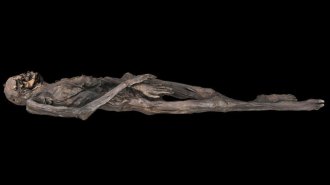Really Cool History
Earlier this week, I wrote about tropical glacier studies by Lonnie Thompson and his colleagues at Ohio State University. On Tuesday, I got a chance to tour Thompson’s labs. Several were quite cool, as in frigid. But that’s the price these scientists pay to preserve some 7,000 ice cores — archives of regional environments around the world, some depicting conditions that existed more than 10,000 years ago.



One core that particularly captured my attention was collected atop Tanzania’s Mt. Kilimanjaro. The glacier there is rapidly evaporating. But Thompson’s crew has extracted one core from the site that contains ice that at its bottom dates back 11,700 years. And at a depth corresponding to 4,200 years ago, this core exhibits a curious 3 millimeter black band. It’s dust, Thompson explains, and appears to help corroborate some ancient archaeological records from Egypt, half a continent away.
Egyptian history archived in ice atop a 15,000-foot glacier in central East Africa? Yep. Not far-fetched at all, he says. Indeed, by marrying physical data from ice cores to anthropological records, Lonnie says, “we can start to figure out the role that climate and environment played on the rise and fall of cultures.”
In fact, lessons from that relationship, he suspects, “can help us adapt to climate change as we go into the 21st century.”
But let’s get back to Egypt, I prod.
Which takes Lonnie back to that black band in the Kilimanjaro ice. A similar signature shows up in glacier cores extracted from atop Andean glaciers, he notes. In the last 13,000 years there’s only one stand-out feature in that South American glacial record. “And it’s from 4,200 years ago — same as in Africa,” he notes.
There’s no written records of what settlements in East Africa and the Andes were experiencing at that time. But there is such a record from Egypt, Lonnie says. “And you find that this period corresponds to the fall of the Old Kingdom, which is when the pyramids were built, and the rise of the Middle Kingdom.”
Inscribed on the tombs of pharaohs are tales describing the histories of their realms. “These are usually glowing tales of conquests and expansion,” Lonnie explains — much like you often hear politicians crow about today.
Except there was one period in Egypt — 4,186 years ago — when the news was anything but upbeat. Hieroglyphic accounts reported tales of people migrating north and south in a search for food. The stories describe sand dunes crossing from one side of the mighty Nile to the other. Horror stories recounted episodes of mass starvation. Further north, in the Middle East, archaeologists have unearthed evidenced of huge cities that came to an abrupt end 4,200 years ago.
The Kilimanjaro black-dust band: “We believe it comes from the Middle East and Africa,” he says. “It appears to record a 300-year drought that impacted the entire region.” And some of that telltale dust appears to have traveled across and up into the Andes.
The question, Thompson says, is how widespread this drought was. Because he also finds markers of it in ice cores he’s brought back from Tibet.
The number and geographic distribution of cores exhibiting the black band allow scientists to probe such apparently devastating events — and show that they can be wide-scale and last centuries.
Keep in mind, Thompson says, these were natural climate anomalies. Currently, humankind is engaged in an unwitting experiment, unleashing humongous quantities of climate-warming carbon into Earth’s atmosphere. There’s every reason to suspect the emissions might trigger unnatural climate anomalies. Ones that could last at least as long and prove as widespread, he says. The big difference: Now there are more than 6 billion people who could be forced to bear the brunt of the changing climate’s impacts.







